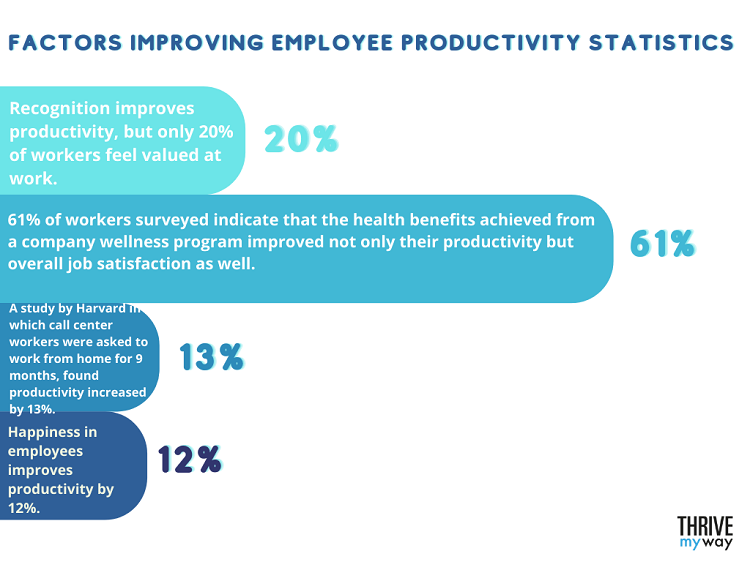Understanding productivity is essential when it comes to running a successful business or organization. Measuring and analyzing productivity enables you to improve the efficiency of your team or company.
Whether calculating productivity in terms of revenue, labor, or tasks, the information can help you make informed decisions about how you operate your business.
If you’re looking to boost your performance this year, take note of the following productivity stats and facts.
Table of Contents
ToggleRemarkable Productivity Statistics 2024
Productivity is an essential aspect of any organization, and understanding the statistics behind it is crucial to achieving success. Here are some remarkable productivity statistics for 2024:
- The average employee is only productive for 2 hours and 53 minutes per day, according to recent studies. This shows the need for better management practices and employee engagement strategies.
- Engaged employees are more productive, resulting in a 21% increase in profits. By creating a positive work environment and fostering employee engagement, organizations can significantly boost productivity levels.
- Stress is a significant factor affecting productivity. Studies show that 41% of stressed employees state that stress negatively affects their productivity. Organizations must implement stress management programs and prioritize employee well-being to ensure a healthy and productive workforce.
- Remote work has become a common practice for many organizations, especially during the pandemic. More than two-thirds of employers have seen increased productivity among their remote workers. This highlights the importance of flexible work arrangements and remote work policies.
- 83% of workers believe that they don’t have to work in an office to be productive. With advancements in technology and communication tools, employees can work from anywhere, making it crucial for organizations to embrace remote work options to attract and retain top talent.
Key Productivity Facts 2024
What exactly is productivity, and how is it measured?
- Productivity is calculated using a standard formula called a productivity ratio:
Output / Input = Productivity - For the economy, productivity is calculated as a ratio of gross domestic product (GDP) to hours worked. Economic growth is measured by tracking the annual percent change of the GDP.
- Labor productivity is the output (of goods or services) per hour. Labor input may be measured in one of two ways. It is either the number of hours worked during a time period or the number of workers.
Workplace Productivity Statistics 2024

Workplace productivity measures how much “work” gets done within a time period and can be measured by the output per work hour or per worker. Factors like communication, technology, and employee engagement can greatly affect productivity in the workplace.
Productivity and Communication Statistics
- According to a survey of 400 corporations with over 100K employees in the U.K. and U.S., miscommunication and communication barriers contributed to an estimated $62.4 million loss in productivity per year.
- As many as 86% of executives indicate that ineffective communication is the most significant cause of productivity issues.
- It is estimated that an average interaction worker (skilled professionals, salespeople, managers, teachers, etc.) spends 28% of their time managing emails and an additional 20% searching for internal information or seeking out a coworker for assistance.
- The McKinsey Global Institute estimates that by fully utilizing social technologies for communication, the average productivity of interaction workers could increase by 20 to 25 percent.
- The internal use of social media for communication within a company could reduce the time spent searching for company information by up to 35%.
Productivity and Technology Statistics
- A 2019 survey of 125 Swedish companies conducted by Schneider Electric found that over half of respondents expected employee productivity to increase with the use of a smart office.
- A study from PricewaterhouseCoopers found that 49% of survey respondents believed wearable technology would increase workplace productivity.
- Video conferencing can save up to 30% in travel costs, and 94% of businesses that use video conferencing regularly indicate that it also improves productivity.
Productivity and Employee Engagement Statistics
- A Gallup study found teams with highly engaged employees have 21% greater profitability than those who don’t.
- Companies with highly engaged employees see a 20% increase in sales and a 10% increase in customer ratings.
- Engaged workers contribute to a 17% increase in overall productivity.
- In a 2008 study of Fortune 100 companies, a 1000% increase in errors was found amongst disengaged employees versus engaged employees.
- Companies in the United States lose up to $550 billion per year thanks to disengaged employees, according to a report by The Engagement Institute.
Productivity and Workplace Trends and Remote Work Statistics
- The COVID-19 pandemic significantly changed how the world did business and how people perceived their jobs. In 2020, 73% of employees in the U.S. said they were actively searching for or monitoring new job opportunities, whereas in 2017, that percentage was 51%. This trend could significantly impact productivity due to the high rate of turnover.
- While the use of virtual meetings is growing in the workplace, so is the feeling of virtual meeting fatigue. Virtira Consulting conducted a study that found 49% of remote employees reported a high level of exhaustion following multiple online meetings each day. The study also found that up to 80% of businesses are planning to go fully remote or implement a hybrid model.
- A global survey of CIOs found that while only 16% of the companies offered remote work prior to COVID-19, as of March 2021, 70% of those companies were currently utilizing remote work. In that same survey, 31% of the respondents anticipated that remote working would be permanent.
Working from Home and Productivity Statistics
Jobs that offer remote work to employees are becoming increasingly popular. But is it wise for companies to “go remote”? Just how does working from home affect productivity?
- In a worldwide survey, 57% of remote workers reported that they were more productive when working remotely, while less than 17% reported that they were less productive, as compared to working in the office prior to the COVID-19 pandemic.
- In a 2020 survey, 71% of employees and 83% of employers deemed working from home a success.
- In a 2018 workplace survey, 64% of business leaders found that offering flexible working options positively impacted productivity. In 2020 and 2021 it was found that the top two benefits of working remotely were a flexible schedule and the flexibility to work from any location.
Work-Life Balance and Productivity Statistics 2024
If productivity measures the amount of work being done, does doing more work make you more productive? Not necessarily. Work-life balance is an important factor for personal productivity.
- Work overload reduces productivity by 68%.
- 3 of the top 10 most productive countries are Scandinavian, where the average employee does not typically work more than a 40-hour work-week, thus resulting in a better work-life balance.
- Employers that encourage work-life balance to double their company’s productivity.
Employee Productivity Statistics 2024
Employees are at the crux of productivity. What factors influence employee productivity, and how can the average employee improve their productivity in the workplace?
General Employee Productivity Statistics
- A survey of nearly 2,000 office workers in the U.K. found that the average employee was productive for approximately 2 hours and 53 minutes each day.
- The average working time prior to a break is approximately 52 minutes for the top 10% of most productive employees
Factors Causing Low Employee Productivity Statistics
- Multitasking is a major hindrance, causing $450 billion in lost productivity worldwide each year.
- Workplace stress is another key factor. On any given day it is estimated that one million workers are absent from work due to work-related stress. This costs businesses approximately $602 per employee each year. On the flip side, workers who come to work stressed still do not function at optimum levels. The International Foundation of Employee Benefit Plans suggests these workers account for $150 billion in productivity losses each year.
- According to a YouGov survey of 1,150 U.S. adults, 30% somewhat or strongly agreed that they would be more productive if they did not have access to their smartphones at work. In the same survey, 42% somewhat or strongly agreed that they waste too much time using their smartphone.
- A survey conducted among over 2,000 employees worldwide found that since the COVID-19 outbreak, the most common challenge inhibiting productivity was difficulty concentrating, affecting 28.3% of those polled.
Factors Improving Employee Productivity Statistics

- Recognition improves productivity by 14%, but only 20% of workers feel valued at work.
- Having a company wellness program can increase productivity. 61% of workers surveyed indicate that the health benefits achieved from a company wellness program improved not only their productivity but overall job satisfaction as well.
- A study by Harvard in which call center workers were asked to work from home for 9 months found productivity increased by 13%. The flexibility of working from home not only boosted productivity but happiness and performance as well. Workers took fewer breaks, and fewer sick days, were more punctual, and increased working minutes by 9%, which led many workers to earn higher bonuses, improving the overall employee experience.
- Happy workers are productive workers. Happiness in employees improves productivity by 12%.
Productivity by Country
Which countries are the most productive? Below are the top 10 ranked OECD countries from 2020 based on the level of GDP per capita in USD, according to the Organization for Economic Co-operation and Development (OECD).
- Luxembourg ($118.73)
- Ireland ($95.51)
- Switzerland ($71.71)
- Norway ($63.29)
- United States ($63.29)
- Denmark ($60.56)
- Netherlands ($59.33)
- Austria ($55.65)
- Iceland ($55.21)
- Sweden ($54.91)
Productivity by Industry Statistics 2024

Each industry has its own challenges to overcome when it comes to productivity growth. Consider the following industry-specific statistics.
Sales Industry Productivity Stats
- Salespeople spend 33% of their day talking with prospects and another 21% communicating by email.
- Up to 50% of sales time is spent with unproductive leads.
- Nearly half of sales organizations do not have effective ways to measure productivity.
- According to the U.S. Bureau of Labor Statistics, in 2020, labor productivity increased by 7.7% in retail trade. It increased by 3.6% in wholesale trade.
- Also in 2020, retail trade saw the highest annual productivity growth since 1987, when it was first measured.
Construction Industry Productivity Stats
- New construction in the United States generated almost $2 trillion in 2019 but dropped to $1.36 trillion in 2020.
- Labor shortages and material costs will likely increase global construction costs by 4.3%.
- 9 out of 10 global infrastructure projects run over budget or are delayed.
- Construction workers spend only 65% of their time actively productive. The other 35% of the time is spent gathering project information, fixing mistakes, or dealing with conflict.
Agriculture Industry Productivity Stats
- The United States exported $139.6 billion worth of agricultural products in 2018.
- About 1% of the U.S. gross domestic product is from farming.
- Farmers will need to produce 70% more food by 2050 in order to account for population growth.
Manufacturing Industry Productivity Stats
- Manufacturing was responsible for about 10.8 % of the total U.S. GDP in 2020.
- Manufacturing saw a 12.4 % decrease in employment from January 2019 to April 2020.
- The U.S. and China hold the top two largest manufacturing industries in the world.
- In the third quarter of 2021, unit labor costs in manufacturing increased by 2.9%.
- For the first time since 1988, when it was first measured, labor productivity growth in U.S. manufacturing decreased between 2010 and 2019.
Productivity Challenges Statistics 2024
Employees may be the ones responsible for getting work done, but businesses must be held accountable too. What are some of the most detrimental issues an organization faces when it comes to worker productivity?
- A survey of 182 senior managers in a range of industries conducted by the University of North Carolina indicated that 71% found meetings to be an unproductive and inefficient use of time. 65% also stated that meetings kept them from completing their own work.
- Poor management is another challenge for productivity. When faced with a bad boss, 48% of workers stated that they intentionally decreased their work effort, and 63% admitted to wasting time at work to simply avoid their boss.
- Employee turnover is a huge drain on productivity, costing both time and money. The United States spends $30.5 billion annually on Millennial turnover alone.
- A toxic workplace contributes to high turnover. 78% of employees indicated they are more likely to seek other employment when faced with toxic workplace culture.
Solutions to Productivity Challenges Statistics 2024
Companies looking to improve productivity need to work from the inside out. Investing in high-quality leadership and creating a positive workplace culture will draw in the happy, highly engaged workers needed for optimum productivity.
- Job-seekers are looking for employers that have a positive work environment. In fact, 46% said company culture is a deciding factor in whether or not they accept a job.
- Team leadership is the number one factor when it comes to company culture. Highly skilled leadership earns a 27% increase in profit per employee.
Other Interesting Productivity Statistics 2024
Countless factors may be taken into consideration when calculating workforce productivity. Here are a few other interesting facts and statistics to ponder.
- It Takes 23 Minutes to Recover From a Distraction at Work
- Gamification is a tactic used by businesses to motivate employees and to positively influence employee engagement and productivity by incorporating game-like mechanics into the job. 89% percent of employees in a 2019 survey indicated that they would be more productive if their jobs had more game-like elements.
- It is estimated that from 2017 to 2021, a total of 121 billion U.S. dollars will be gained worldwide via improved productivity as a result of the adoption of Artificial Intelligence in customer management activities.
- American companies lose $63 billion each year because of tired employees who are less productive than those who are well-rested.
- According to the U.S. Bureau of Labor Statistics, multifactor productivity (now called total factor productivity) decreased in 76% of major industries in 2020, with the largest decreases in the arts, entertainment, and recreation.
You might be interested to check those related posts as well:
- 107 Remote Work Stats [Every Employer Must Know] In 2024
- 30+ Cool Business Automation Statistics [for Growth] 2024
- 14 Amazing Morning Routine Stats 2024 [Facts and Importance]
FAQs
What are the must-know statistics on productivity?
- Multitasking can reduce productivity by up to 40% – studies have shown that attempting to work on multiple tasks at once can actually decrease overall productivity.
- The average worker is productive for only 2 hours and 53 minutes per day – this means that a significant amount of time in the average workday is spent on non-productive tasks like checking emails and social media, attending meetings, and handling administrative tasks.
- Regular breaks can improve productivity – taking short, frequent breaks throughout the workday can actually increase productivity and reduce fatigue.
What is a good or acceptable productivity rate?
A “good” or even “acceptable” productivity rate is incredibly subjective. However, experts suggest implementing a “70% rule” to help improve productivity. If a worker continuously performs at maximum capacity, he or she runs the risk of burning out.
The 70% rule suggests working most of the time productively but with less intensity. This allows the employee some mental reserve to respond to any short-term urgent demands that may arise.
Implementing the 70% rule involves taking mini-breaks during the workday, reserving unscheduled work time, and taking periodic vacations.
What percentage of the workday is productive?
If the average employee is productive for 2 hours and 53 minutes each day, this amounts to approximately 36% of the working day. Freelancers, on the other hand, are productive for about 87.5% of the working day.
What percentage of workers claim that stress negatively affects productivity?
Stress negatively affects productivity for 41% of workers. Additionally, 33% say stress lowers their engagement at work.
Conclusion
If you want your business to thrive, understanding and growing productivity is crucial. The key to maximum productivity in the workplace is not more work done, but satisfied employees who feel supported by their employers and enjoy the work they do.
Statistics for this article were collected from the following sources:
- Bryan College
- Condeco
- Digital in the Round
- IndustryWeek
- Forbes
- Gallup
- GlobeNewsWire
- GoRemotely
- Harvard Business Review
- Health Advocate
- Insync
- McKinsey & Company
- NIST
- OECD
- Policy Advice
- ProofHub
- Sales Hacker
- Stress.org
- TeamStage
- Tech Republic
- The American Farm Bureau Federation
- Tiny Pulse
- Training Industry
- Upwork
- U.S. Bureau of Labor and StatisticsVoucherCloud
- WhatIs.com
- Workplace Gender Equality Agency


